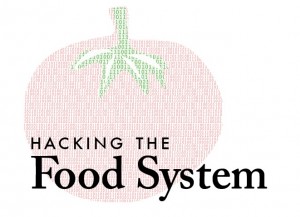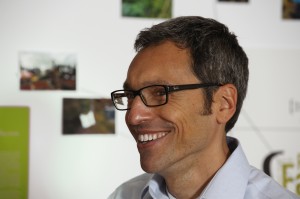[Hacking the Food System is an online conversation exploring how technology, information and data can change the food system status quo. Join the conversation below, on Twitter (hashtag #foodtech), or Facebook.]
The future of urban agriculture is not vertical, nor even simply horizontal. It is distributed and networked throughout the city. In a growing number of cities, suburbs,and small towns, community groups and entrepreneurs have discovered innovative ways to harvest and grow food, using interconnected networks of relatively small plots of public and private land and shared resources. In the process, they are forging novel relationships among producers and consumers.
These ventures are unique in that they apply social networking tools, mapping technologies, unusual land tenure arrangements, and novel business models to forage and farm cities and suburbs. In addition, while they are grassroots, and based on aggregated small-scale production, collection, and distribution, they are replicable components of a civic agriculture network that has the potential to scale up, producing an increasing amount of food in cities and suburbs, putting urban land to productive use, recovering food that would otherwise be wasted, and helping to re-localize urban food systems.
The programs and businesses are distinctive because they are tailored to the unique people and places in which they are created. However, they generally fall into one of the following broad categories:
(1) Gleaning Social Networks – urban foragers who harvest fruits, nuts, and other edibles growing on public spaces and, sometimes, on private land, often to contribute this bounty to the needy;
(2) Peer-to-Peer Agriculture – networks of urban landowners who lend their properties,perhaps as little as a rear or side yard, to those with the inclination to produce food, in some cases to share the bounty and in other cases simply for altruistic reasons;
(3) Aggregated Urban Micro-Farms – urban farmers who aggregate multiple small parcels of privately owned land into quantities that are cost-effective to farm. The food production is either provided for a fee or for a share of the produce, which is in some cases distributed through a CSA model.
Gleaning Social Networks
Gleaning, or collecting the excess crops on farmers’ fields to donate the food to the needy, is an ancient practice referred to in the Old Testament. In recent years, a number of gleaning social networks like Forage Oakland have emerged to educate the public about the availability of edible landscapes in their community, and to encourage the collection of fruits, nuts, and other food growing in public (and with permission) private spaces. Sponsoring groups have organized events to harvest fruit, produced online maps illustrating where publicly accessible fruits, nuts, and berries can be found, and have facilitated the distribution of excess produce gleaned from these sources. These programs not only facilitate the consumption of food already being produced in a community, but by making these resources visible and demonstrating the benefits of edible landscapes, hope to promote the planting of fruit and nut trees as a viable way to produce food in cities.
Peer-to-Peer Agriculture
Exchange and sharing networks (ie., Growfriend.org) are designed to more productively use the land that exists in people’s yards for food production. They range from websites that link those with available land who are willing to allow landless residents interested in gardening to grow food on their property to more complex social networks that facilitate land sharing and also food bartering. These schemes rely for their success on citizens willing to enter into non-financial relationships with others to either achieve mutual gain or the simple satisfaction of turning a fallow resource (such as their unused yard space) into a more productive space.
Aggregated Urban Micro-Farms
Cities have significant amounts of land suitable for growing food, divided into yards of varying size and shape. Some entrepreneurial gardeners have created businesses turning backyards into intensive vegetable patches, often for a simple fee for service. In other cases the business model involves aggregating a number of intensively planted micro- farms into a scale that produces sufficient food to operate a viable CSA subscription service (Your Backyard Farmer). To the participating land owners, who provide the property to grow food and get a weekly box of produce in return, this system offers a greater variety of food than can be grown on one’s own particular parcel. Moreover, depending on their level of interest, skills, and time, households may also participate in some or much of the planting, tending, and harvesting.
The distributed farming models offer the possibility of increasing food production in cities and suburbs through networks of small-scale efforts powered by social media and innovative apps. While each project contributes a very small percentage of a city’s food supply, in the aggregate a significant amount of food can be produced if intensive farming techniques are used. Indeed, a distributed farming system may be the most suited to fitting food production into the existing urban landscape, which is a patchwork of vacant land, yards, and rooftops owned by individuals, businesses and government agencies.
______________________
Nevin Cohen is an Assistant Professor of Environmental Studies at The New School, where he teaches courses in urban planning and food systems. Dr. Cohen’s current research focuses on urban food policy, particularly innovative planning strategies to support food production in the urban and peri-urban landscape, public policies to engage citizens in sustainable food production, urban planning and food access, and civic agriculture in cities and suburbs. He has a Ph.D. in Urban Planning from Rutgers University, a Masters in City and Regional Planning from Berkeley, and a BA from Cornell.
You can follow him on twitter at @urbanfoodpolicy.
Related articles
- Joanne Wilson on Hacking the Food System (foodandtechconnect.com)
- Ali Partovi on Hacking the Food System: Focus on the Supply Chain (foodandtechconnect.com)
- Carl DiSalvo on Hacking the Food System: Reinvent Ag-Tech (foodandtechconnect.com)
- Dickson Despommier on Hacking the Food System (foodandtechconnect.com)
- Marcus Samuelsson on Hacking the Food System: Taking Food to a Whole New Level (foodandtechconnect.com)
- Bill Niman on Hacking the Food System (foodandtechconnect.com)
- Stefani Bardin on Hacking the Food System (foodandtechconnect.com)
- Ryan Charles on Hacking the Food System: One Aisle Supermarket? (foodandtechconnect.com)
- Hilary Mason on Hacking the Food System: The Story of the Ultimate Cookie (foodandtechconnect.com)
- Jeff Miller on Hacking the Food System: The Final Link (foodandtechconnect.com)





